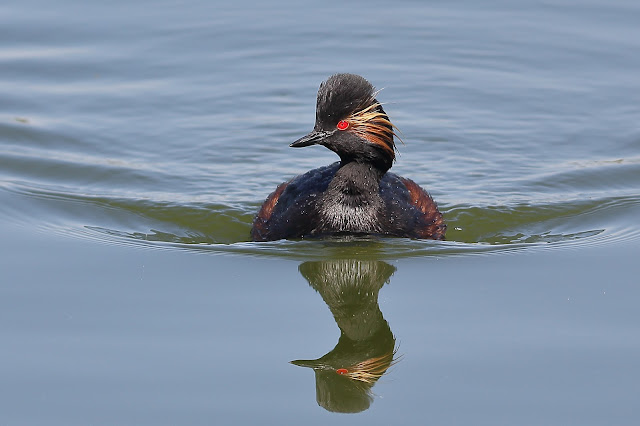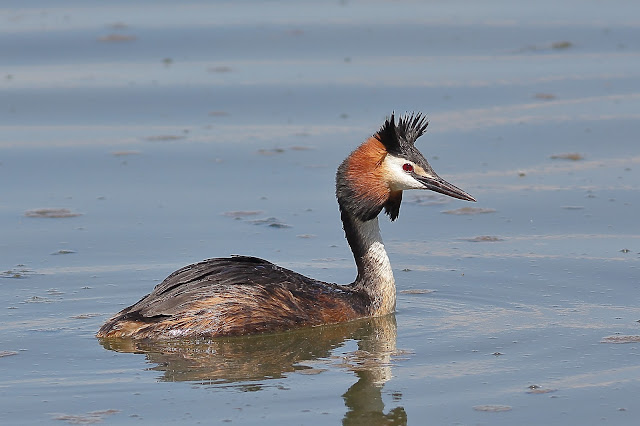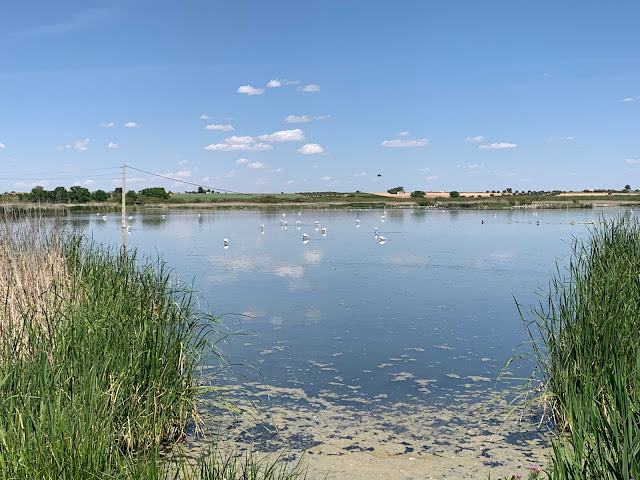Hola una vez más.
Hi again.
Hi again.
En el siguiente enlace podéis ver nuestros próximos viajes fotográficos y de observación de aves y mamíferos nacionales y al extranjero. Espero que os gusten y os animéis a venir conmigo. Una experiencia que nunca olvidareis.
In the following link you can see our next national and foreign Birds and Mammals photographic and observation trips. I hope you like them and I encourage you to come with me. An experience that you will not forget.
En esta ocasión os enseño algunas de las fotos que pude sacar en una excursión a La Mancha Húmeda que tanto me gusta a principios de mayo.
This time I show you some of the photos I was able to take on an excursion to La Mancha Húmeda that I like so much at the beginning of May.
Las lagunas tenían muy poca agua a pesar de la primavera tan lluviosa que hemos tenido. La mayoría estaban secas y solo tenían agua las que tienen aportes de aguas residuales.
Lagoons had very little water despite the rainy spring we have had. Most of them were dry and only those with sewage inflows had water.
Las lagunas que visité fueron los Charcones de Miguel Esteban, Alcazar de San Juan y Navaseca.
The lagoons I visited were Charcones de Miguel Esteban, Alcazar de San Juan and Navaseca.
El tiempo fue muy bueno pues no hizo calor y lucio el sol durante todo el día.
The weather was very good because it was not hot and the sun shone throughout the day.
Cada vez veo menos galápagos leprosos (Mauremys leprosa)en nuestros humedales.
I see fewer and fewer Spanish Leprous Pond Turtles in our wetlands.
Había bastantes porrones europeos (Aythya
ferina). En la imagen un macho pues, como es época de reproducción, las hembras en su mayoría estaban incubando.
There were quite a few Common
Pochard. In the photo a male because, as it is the breeding season, most of the females were incubating.
Vimos bastantes malvasías cabeciblancas (Oxyura
leucocephala). Al igual que como os contaba antes, en su mayoría machos.
We saw quite a few White-headed Ducks (Oxyura leucocephala). As I told you before, mostly males.
Algunos machos no presentaban toda su cara blanca al tratarse de individuos de primer verano de variante de cabeza oscura.
Some males did not have their entire white face as they were first-summer individuals of the dark-headed variant.
Me encanta ver cuando hacen parte del cortejo con sus llamadas y estirando mucho la cola y el cuello.
I love to see when they make part of the courtship with their calls and stretching their tails and necks.
Uno de los patos que podemos ver en el interior peninsular que más me gustan, el pato colorado (Netta
rufina). El de esta foto es un macho.
One of the ducks that we can see in the center of Spain that I like the most, the Red-crested
Pochard. The one in this photo is a male.
Mira que son bonitos.
Aren't they beautiful?
Las hembras son menos coloridas pues deben pasar desapercibidas durante el tiempo de la incubación y cría de los pollos.
Females are less colorful because they must go unnoticed during incubation and rearing of ducklings.
Sin embargo en los zampullines y somormujos, no hay dimorfismo sexual entre macho y hembra y ambos padres se encargan de la incubación y cuidado de las crías hasta su emancipación. En la foto una pareja de zampullín cuellinegro (Podiceps
nigricollis).
However, in Grebes, there is no sexual dimorphism between the male and female and both parents are responsible for incubating and caring for the young until they emancipate. In the photo a pair of Black-necked Grebe.
Otra especie que me gusta muchísimo.
Another species that I really like.
Un macho de ánade friso (Anas
strepera). Como se puede apreciar en la foto, los machos de ánade friso comienzan muy pronto a mudar a plumaje de eclipse.
A male Gadwalla. As you can see in the photo, male Gadwalls start moulting into eclipse plumage very early.
Ya se podían ver algunas fochas comunes (Fulica
atra) con crías.
Some Common Coots with hatchlings could already be seen.
Pagaza piconegra (Gelochelidon
nilotica).
Gull-billed
Tern.
Lo que más me gustó de la excursión fue poder ver una familia de búhos chicos (Asio otus). En la foto uno de los adultos.
What I liked most oft the excursion was being able to spot a family of Long-eared Owl. In the photo one of the adults.
Un chorlitejo grande (Charadrius
hiaticula).
A Great
Ringed Plover.
Vimos varias parejas de aguilucho lagunero occidental (Circus
aeruginosus). En la foto un macho adulto.
We saw several pairs of Eurasian Marsh Harrier. In the photo an adult male.
Fumarel cariblanco (Chlidonias
hybridus).
Whiskered
Tern.
Un macho de ánade azulón (Anas
platyrhynchos).
A male of Mallard.
Una hembra.
A female.
Había varias parejas de somormujo lavanco (Podiceps
cristatus).
There were several pairs of Great Crested Grebe.
Me hace mucha gracia también por detrás.
It makes me very funny also from behind.
Macho de malvasía cabeciblanca (Oxyura
leucocephala). El pico es impresionante.
Male White-headed Duck. His peak is awesome.
Hmeba.
Female.
Un vídeo de como los machos cortejan a las hembras, Varios machos y una sola hembra.
A video of how males court females, Several males and a single female.
Como suele ser habitual vimos y oímos varios cetia ruiseñor (Cettia cetti) pero solo pude fotografiar a este.
As usual we saw and heard several Cetti's
Warbler but I was only able to photograph this one.
Había muchos flamencos comunes (Phoenicopterus
ruber).
There were many Greater
Flamingos.
Gallineta común (Gallinula
chloropus).
Moorhen.
Muy pocos cuchara común (Spatula
clypeata) se quedan el el centro peninsular para reproducirse. En la foto un macho.
Very few Northern
Shoveler stay in the center of the peninsula to reproduce. In the photo a male.
Había moritos comunes (Plegadis
falcinellus) tanto de primer verano como adultos. Solo fotografié a los adultos pues son más llamativos cuando están en plumaje nupcial.
There were Glossy Ibis (Plegadis falcinellus) both first summer and adults. I only photographed adults as they are most beautiful when in breeding plumage.
Por lo menos había ocho fumareles comunes (Chlidonias
niger). Esta especie raramente se reproduce en el interior peninsular y se la ve más cuando migran hacia el norte.
There were at least eight Black Tern. This species rarely breeds in the interior of the peninsula and is seen more when they migrate north.
Andarríos chico (Actitis
hypoleucos).
Common
Sandpiper.
También había bastantes tarros blancos (Tadorna
tadorna). En las fotos solo machos.
There were also quite a few Common Shelduck. In the photos only males.
Un bonito macho de cigüeñuela común (Himantopus
himantopus).
A beautiful Black-winged
Stilt male.
Más zampullines cuellinegros (Podiceps
nigricollis).
More Black-necked
Grebe.
Había bastantes carriceros tordales (Acrocephalus arundinaceus) y comunes (Acrocephalus scirpaceus). Solo pude fotografiar a los tordales pues los comunes no les gusta subir tanto a cantar en los las partes más altas de los carrizos y al quedarse a media altura no se les puede fotografiar tan bien.
There were quite a few Reed Warbler and Great
Reed Warbler. I was only able to photograph Great Reed Warbler because the others do not like to climb so high to sing in the highest parts of reeds and when they stay at medium height they cannot be photographed as well.
Otra de las bonitas especies que se vienen a reproducir a España. los abejarucos europeos (Merops
apiaster). Son toda una belleza.
Another of the beautiful species that come to reproduce in Spain. European Bee-eaters. They are quite a beauty.
Las gaviotas reidoras (Chroicocephalus
ridibundus) estaban ya incubando.
Black-headed
Gulls were already incubating.
Un archibebe común (Tringa
totanus).
A Common
Redshank.
Avoceta común (Recurvirostra
avosetta). Es una de las pocas aves que si pico es curvado hacia arriba.
Pied Avocet. It is one of the few Birds whose beak is curved upwards.
Solo pude ver una espátula común (Platalea
leucorodia). Era un adulto en plumaje reproductor.
I could only see a single Eurasian
Spoonbill. It was an adult in breeding plumage.
Había bastantes ánsares comunes (Anser
anser) y algunos con crías.
There were quite a few Greylag Geese and some with goslings.
Otra belleza estival, la carraca europea (Coracias
garrulus). Vimos una pareja.
Another summer beauty, the European Roller . We saw a couple.
Y para finalizar os he subido esta foto de la vistas desde uno de los observatorios en los que estuve.
And to finish I have uploaded this photo of the views from one of the observatories where I was.
Si queréis suscribiros a este blog de los viajes que hacemos pincha en el siguiente enlace: Suscribirse y haz clic en ¿Quieres suscribirte a nuestro blog?
If you want to subscribe to this post about the trips we do, click on the following link: Susbcribe and click on: Do you want to subscribe to our blog?
Espero que os haya gustado y hasta pronto.
I hope you like it and see you soon.



















































































No hay comentarios:
Publicar un comentario